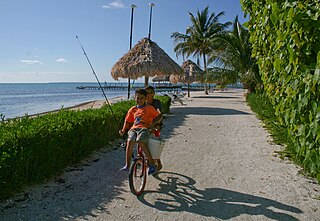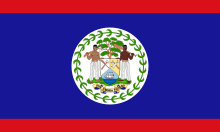
Belize is a country on the north-eastern coast of Central America. It is bordered by Mexico to the north, the Caribbean Sea to the east, and Guatemala to the west and south. It also shares a water boundary with Honduras to the southeast. It has an area of 22,970 square kilometres (8,867 sq mi) and a population of 441,471 (2022). Its mainland is about 290 km (180 mi) long and 110 km (68 mi) wide. It is the least populated and least densely populated country in Central America. Its population growth rate of 1.87% per year is the second-highest in the region and one of the highest in the Western Hemisphere. Its capital is Belmopan, and its largest city is the namesake city of Belize City. Belize is often thought of as a Caribbean country in Central America because it has a history similar to that of English-speaking Caribbean nations. Belize's institutions and official language reflect its history as a British colony.

Demographics of the population of Belize include population density, ethnicity, education level, health of the populace, economic status, religious affiliations and other aspects.

Punta Gorda, known locally as P.G., is the capital and largest town of Toledo District in southern Belize. Punta Gorda is the southernmost sizable town in the nation, with a population of about 5,000 people. Although the town bears a Spanish name, its inhabitants are mostly Kriol/English-speaking and are primarily of Garifuna, East Indian, Kriol, and Maya descent.

Corozal Town is a town in Belize, capital of Corozal District. Corozal Town is located about 84 miles north of Belize City, and 9 miles from the border with Mexico. The population of Corozal Town, according to the main results of the 2010 census, is 9,871.

Orange Walk Town is the fourth largest town in Belize, with a population of about 13,400. It is the capital of the Orange Walk District. Orange Walk Town is located on the left bank of the New River, 53 miles (85 km) north of Belize City and 30 miles (48 km) south of Corozal Town. Despite the English name of the city, its residents are primarily Spanish-speaking mestizos. The city is in a very low-lying area of Belize, though the police station sits atop a buried Mayan pyramid at 49 m (161 ft) tall.
Progreso is a village in the Corozal District of the nation of Belize.
Little Belize is a colony of conservative Plautdietsch-speaking "Russian" Mennonites, known as "Old Colony Mennonites", in the Corozal District of Belize. It is part of the Corozal South East constituency. Little Belize is located east of Progresso at an elevation of 1 meter above sea level. Because the Mennonite colony is close to Progresso, it is sometimes called "Progresso".
Chunox is a village located in the Corozal District of Belize, with a population of 1,143 people. It is primarily an agricultural community surrounded by sugar cane fields, and is located on the east bank of Laguna Seca. The official language is English, but most residents speak Spanish due to their Maya Mestizo ancestry. St. Viator Vocational High School serves the village. There are several Maya residential mound groups in Chunox from the Classic Period. Copper Bank, a fishing village, is situated across the lagoon from Chunox.

Belizean Creole is an English-based creole language spoken by the Belizean Creole people. It is closely related to Miskito Coastal Creole, San Andrés-Providencia Creole, and Jamaican Patois.
Mopan is a language that belongs to the Yucatecan branch of the Mayan languages. It is spoken by the Mopan people who live in the Petén Department of Guatemala and in the Maya Mountains region of Belize. There are between three and four thousand Mopan speakers in Guatemala and six to eight thousand in Belize.

San Joaquín is a village in the Corozal District of Belize. It is one of the largest villages in Corozal. The town was formed as a result of Mestizos migrating to escape the 1847–1901 Caste War of Yucatán.

The culture of Belize is a mix of influences and people from Kriol, Maya, East Indian, Garinagu, Mestizo, Mennonites who are of German descent, with many other cultures from Chinese to Lebanese. It is a unique blend that emerged through the country's long and occasionally violent history.

Calcutta is a village in the Corozal District of Belize.
Sarteneja is the largest fishing community and the second largest village in Belize. It recorded a population of 3,500 according to a 2016 estimate. The name Sarteneja is a Castilian distortion of its original Mayan name Tza-ten-a-ha, which means 'give me water'.

Copper Bank is a fishing village in the Corozal District of Belize. It is situated on the west bank of Laguna Seca, a shallow lagoon that empties into Chetumal Bay just north-east of the village. The closest settlement is Chunox, located approximately 1.25 miles away on the east bank of the Laguna Seca.

Belizeans are people associated with the country of Belize through citizenship or descent. Belize is a multiethnic country with residents of Ethnic groups of Amerindian, African, European, Asian and Middle-eastern descent or mixed race with any combination of those groups.

Hispanic and Latin American Belizeans are Belizeans of full or partial Hispanic and Latin American descent. Currently, they comprise around 52.9% of Belize's population.
Chan Chen is a village located in Corozal District, Belize. Most of the inhabitants speak Spanish or Yucatec Maya, along with some English. The name Chan Chen is Yucatec maya meaning "small well" in English. Most Chan Chen inhabitants are of Maya ancestry.
Cristo Rey is a village in the Corozal District of Belize.
San Pedro is a small village in the Corozal District in the nation of Belize. It is part of the Corozal North constituency.













